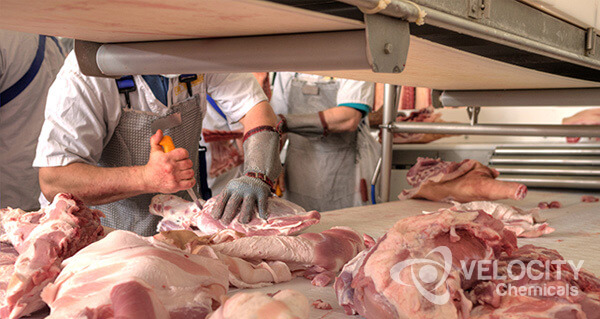The 5 Most Effective Sanitizing Chemicals For Food Processing Operations
 Between industry demands for high standards of cleanliness and the general expectation of more eco-friendly adherence, finding the right sanitizer for your food processing or food handling operation is not always easy. Often the situation influences the type of sanitizing chemicals needed, as well as the formulas that make them up.
Still, the choice of truly effective sanitizing chemicals is pretty concise. At Velocity Chemicals, even though we often create customized formulas for our customers, we note that only a handful of compounds are used widely. The question is simply which works best in a specific sector, and food processing, dairy, poultry and livestock farming, as well as arable and fruit farming, are all sectors that can benefit from them.
Influencers can range from industry specifics to temperatures and water pH, but principally it’s the common types of microorganisms that working surfaces pick up and what works best against them. To illustrate how varied these aspects can be, we’ve put together a list of the 5 most effective sanitizing chemicals used in cleaning and sanitizing products today.
Between industry demands for high standards of cleanliness and the general expectation of more eco-friendly adherence, finding the right sanitizer for your food processing or food handling operation is not always easy. Often the situation influences the type of sanitizing chemicals needed, as well as the formulas that make them up.
Still, the choice of truly effective sanitizing chemicals is pretty concise. At Velocity Chemicals, even though we often create customized formulas for our customers, we note that only a handful of compounds are used widely. The question is simply which works best in a specific sector, and food processing, dairy, poultry and livestock farming, as well as arable and fruit farming, are all sectors that can benefit from them.
Influencers can range from industry specifics to temperatures and water pH, but principally it’s the common types of microorganisms that working surfaces pick up and what works best against them. To illustrate how varied these aspects can be, we’ve put together a list of the 5 most effective sanitizing chemicals used in cleaning and sanitizing products today.

5 Most Effective Sanitizing Chemicals
- Hypochlorites – Probably the most commonly found chemical in sanitizers, hypochlorite and its compounds are highly effective in killing microbes. Not only that, they can also successfully destroy microbe DNA. However, spores do have a resistance to hypochlorites because their outer coat is not susceptible to the strong oxidizing nature of the chemical. There are negatives to using them too, however, mostly related to surface and water conditions, the risk of corrosion, and some health concerns. Soils on the area to be sanitized have to be removed to ensure high effectiveness, while water pH must be between 5 and 7. The water must also be clear of impurities, and high temperatures tend to lessen efficacy, but the overall effectiveness and safety levels make it extremely popular across North America.
- Chlorine Dioxide – Although known as explosive in its gas form, this inorganic compound is safe in a liquid solution. It is highly effective against bacteria, viruses and fungi as it reacts with proteins and fatty acids to break down the organisms structurally. Chlorine Dioxide is effective in low concentrations, with just a 5 ppm solution enough to adequately sanitize food contact surfaces with contact time of less than 1 minute. It can work fine in water containing organic material, but its effectiveness does lower proportionally with the amount of material that exists. It is also environmentally friendly.
- Iodophors – Effective as both a sanitizer and a disinfectant, the real advantage that Iodophors have over other chemicals is its sustained release effect. It means that microbes are killed steadily over an extended period of time, ensuring a surface stays clean and sanitized for longer. Iodophors work by attaching themselves to sulfurs in proteins, which basically warrants them inactive. It also works well in slightly more acidic solutions, and requires relatively low concentrations (25 ppm) over short contact periods (1 minute) to do its job. And although they can stain some surfaces (due to the presence of iodine), the EPA confirms they are environmentally friendly.
- Peroxyacetic Acid (PAA) – Effective against most microorganisms, Peroxyacetic Acid (or PAA as it’s generally referred to as) can work very well in colder temperatures, especially when they are paired with stabilized hydrogen peroxide. Even at temperatures as low as 4C, it records high levels of microbe mortality, which in turn makes it ideal in food processing areas where lower-than-ambient temperatures are necessary. PAA is also effective against biofilms but is less effective as water pH nears neutral and, depending on requirements, can be used at concentrations from 100-200 ppm (peroxyacetic acid) and 80-600 ppm (hydrogen peroxide). PAA-based sanitizers are environmentally friendly and less corrosive to equipment than hypochlorites, but concentrated PAA can be a safety hazard.
- Quaternary Ammonium Compounds (QACs or Quats) – One of the more complex compounds found in sanitizers, QACs comprise nitrogen bound to 4 different organic groups. They work by blocking a microbe’s nutritional intake process, effectively starving them, but it has no real effect on spores. As sanitizers, they are usually applied at concentrations of 200 ppm and allowed to dry, at which point the QAC residue continues to work. They are usually odorless, non-staining, non-corrosive and relatively non-toxic to users, and while heavy soil and hard water can severely lessen effectiveness, chelating agents can be added to some compounds to counter these issues. Also, while they can be discharged into the environment, the concentration is low so that they have no negative effect.
Sanitizing Products From Velocity Chemicals
Velocity Chemical’s VELOSAN is a QAC specifically designed to sanitize hard surfaces in food processing and industrial areas to the highest standards. CFIA approved, it’s an effective one-step sanitizer for both food contact and non-food contact surfaces where rinsing is not required, thus allowing it to dry so that the residue works over an extended period. However, unlike some QAC products, it is also a non-acid disinfectant with no phosphates, and is hard water and organic soil tolerant.
For more information on how VELOSAN can meet your sanitizing requirements, talk to one of our product specialists at 1-888-963-9499, or email us today!
Tags: Food Processing, Sanitizing




